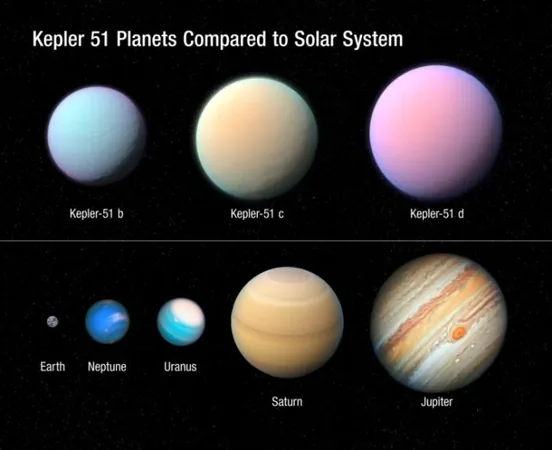
Astronomers Discover a Fourth Planet in the Quirkiest System of the Milky Way!
2024-12-24
Author: Jia
A Remarkable Discovery 2,600 Light-Years Away
A staggering 2,600 light-years away in the Milky Way lies the intriguing planetary system of Kepler-51, a unique realm that has astounded astronomers and sparked a flurry of excitement upon the recent discovery of a fourth planet.
The Unique Characteristics of Kepler-51
Originally uncovered in 2012, the star at the heart of this system is a Sun-like yellow dwarf, orbiting three exoplanets whose densities are astonishingly lighter than cotton candy—hence their endearing nickname, "super-puff worlds." The excitement around these gas giants surged when scientists first established their unusual characteristics in 2019, uncovering that each planet has a density of less than 0.1 grams per cubic centimeter.
Introduction of Kepler-51e
Now, in a surprising twist, a team of astronomers led by Jessica Libby-Roberts from Pennsylvania State University and Kento Masuda of Osaka University has revealed the existence of a fourth exoplanet, named Kepler-51e. This new addition has raised more questions than answers regarding the formation of super-puff planets, which are typically isolated in planetary systems.
The Challenge of Discovery
Libby-Roberts explains the challenge: "Super puff planets are fairly rare, and multiple occurrences in one system are particularly perplexing." With the discovery of Kepler-51e, researchers are now racing to uncover whether it too belongs to this peculiar category.
Observational Challenges and Surprises
The team initially set out to observe one of the known planets during its transit, a method used to measure the planet's properties based on the dip in stellar brightness. However, the observatory efforts at Apache Point and the James Webb Space Telescope did not go as planned, leading to a frantic reassessment of their approach. A serendipitous early observation revealed unexpected activity in the star's brightness that hinted at the gravitational influence of the newly discovered Kepler-51e.
Characteristics of the Newly Discovered Planet
This fourth planet is speculated to possess a mass similar to Kepler-51b, c, and d, and orbits the star in a roughly circular path taking about 264 days. While it hasn't been observed transiting, meaning its size and density remain unknown, its mere presence among three other light, puffy worlds cements Kepler-51's status as an astronomical wonder.
Future Investigations
Further investigations will aim to probe into the atmospheres of these super-puff planets to unravel their compositions and the peculiar dynamics at play. The answers to these cosmic mysteries could change our understanding of planetary formation entirely.
Looking Ahead
With more data on the horizon, the future of the Kepler-51 system looks incredibly exciting, promising to enchant astronomers and space enthusiasts alike as they continue their quest to unlock the secrets of this fluffy celestial system.
Publication and Anticipation
The groundbreaking research has been published in *The Astronomical Journal*, paving the way for further exploration of this fascinating planetary ensemble. What other surprises might Kepler-51 hold? Stay tuned!


 Brasil (PT)
Brasil (PT)
 Canada (EN)
Canada (EN)
 Chile (ES)
Chile (ES)
 España (ES)
España (ES)
 France (FR)
France (FR)
 Hong Kong (EN)
Hong Kong (EN)
 Italia (IT)
Italia (IT)
 日本 (JA)
日本 (JA)
 Magyarország (HU)
Magyarország (HU)
 Norge (NO)
Norge (NO)
 Polska (PL)
Polska (PL)
 Schweiz (DE)
Schweiz (DE)
 Singapore (EN)
Singapore (EN)
 Sverige (SV)
Sverige (SV)
 Suomi (FI)
Suomi (FI)
 Türkiye (TR)
Türkiye (TR)